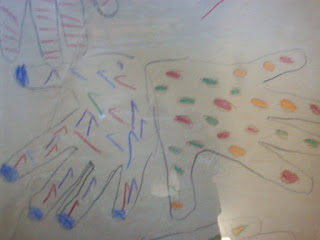Tuesday, June 2, 2009
Art Speaks Louder Than Words
Thursday, May 28, 2009
Why Art Therapy?
Feel free to contact me for more information on art therapy and how and where it is used and its benefits.
Peace
Thursday, May 21, 2009
In Sickness & In Health - allow Art to Lead The Way
 My hand drawing from first grade...who knew?
My hand drawing from first grade...who knew?Peace
Monday, May 18, 2009
COLLAGING
I'm a big supporter of the art-making process of collage. The Oxford Pocket Dictionary defines "collage" as work of art in which various materials are arranged and glued to a backing. I would like to add, that found objects such as shells, , fabrics, photographs, tree bark, string, yarn and different textured papers can be included in a collage. You can mix mediums and use them to draw or paint onto the collage, for instance including paint, colored pencils and markers. I use collage with clients because it takes the pressure of having to draw or paint away from the art-making process. What else I enjoy about working with collage is that whatever issue a person is working on or trying to understand in their life, collage offers a nonintimidating method to explore thoughts and feelings. Magazine cut-outs provide a variety of images that can be used to represent thoughts and feelings. For instance, lets say an individual wanted a deeper understanding of his or her relationship with their sister. I might suggest that they choose images that reflect what he or she likes about their sister and images that represent what they do not like. I usually recommend that they choose between 8 and 10 images so that they are not using the entire session to go through the many picture cut-outs. Once the pictures are glued down, I will ask clients to talk about the process and share any thoughts or feelings they have about the images they chose. Together we explore the art.
Try it for yourself:
Exercise: Introduce yourself with images. Instead of introducing yourself with words, you will do it with images.
Begin collecting magazine picture cut-outs such as people, animals, places, buildings, plants, sayings, words, things, etc. Keep them in a box.
You'll need: glue, scissors, large plain paper or cardboard.
This can be a work in process. Start by choosing images that you feel define who you are, where you are in your life and other aspects of yourself you would like to share.
Glue images to the paper/board in away you wish. Overlapping if you choose.
Continue until you feel your collage is complete. Reflect on the process and if you wish, you may write a short story or poem about the collage/process.
Title your collage.
Wednesday, May 13, 2009
Being Fired...Can Be A Blessing in Disguise
Tuesday, May 12, 2009
Using Collage to Tell the Story of Your Life
"Enough is Enough" a time for change
 To the left, my art-piece Kali-Ma. This goddess represents my inner demons that I work hard to understand and abolish such as negative self talk and doubt. She is also with me in my fight to be heard from my healthcare team and insurance companies.
To the left, my art-piece Kali-Ma. This goddess represents my inner demons that I work hard to understand and abolish such as negative self talk and doubt. She is also with me in my fight to be heard from my healthcare team and insurance companies. I've been reading Jean Shinoda Bolen's book, "Goddesses in Older Women...archetypes in women over fifty," and can not put it down. I've found wonderful ideas for art directives as I turn the pages of this fascinating book. In the chapter titled Goddesses of Transformative Wrath: Her Name is Outrage, Bolen speaks of the goddesses who come forth when it is time for us to take ction in order to make changes in our lives, or as she writes, when enough is enough. The two goddesses Bolen includes in this chapter include Sekhmet, the ancient Egyptian Lionheaded goddess and Kali-Ma, Hindu destroyer goddess. These goddesses come into our lives when it is time for change, when we have stayed in a relationship too long, or a job, or to speak out about a cause close to your heart. I am writing about this subject in Creative Journey instead of Wisewomen because of how we can use an idea such as enough is enough to go deeper into this idea with creative self-expression. I would like to suggest that with the theme of enough is enough, you create a collage, write a poem, drawing, painting or short story addressing this subject in your life today. Begin by writing the words enough is enough on a piece of paper, focus on the words, close your eyes and repeat the words. Be aware of what images come to mind as you say these words. When an image comes to you, begin to put the image down on paper. It might come in the way of words or images. Continue to work with this piece as you allow the paper to hold what it is you have had enough of in your life. When finished, reflect on the piece and let it speak to you. You may wish to add to it at a later time. If you are in therapy, bring it with you to share with your therapist. Many times when we engage in art-making feelings can surface so seek support from a professional if you need to. And remember, to be with the process.
Victoria


